wheel torque TOYOTA HIGHLANDER HYBRID 2019 Owners Manual (in English)
[x] Cancel search | Manufacturer: TOYOTA, Model Year: 2019, Model line: HIGHLANDER HYBRID, Model: TOYOTA HIGHLANDER HYBRID 2019Pages: 716, PDF Size: 14.31 MB
Page 206 of 716

2064-1. Before driving
HIGHLANDER_HV_U
WARNING
Observe the following precautions.
Failure to do so may result in death or serious injury.
■When braking
● When the brakes are wet, drive more cautiously.
Braking distance increases when the brakes are wet, and this ma y cause
one side of the vehicle to brake differently than the other sid e. Also, the
parking brake may not securely hold the vehicle.
● If the electronically controlled brake system does not operate, do not fol-
low other vehicles closely and avoid hills or sharp turns that require brak-
ing.
In this case, braking is still possible, but the brake pedal sh ould be
depressed more firmly than usual. Also, the braking distance wi ll increase.
Have your brakes fixed immediately.
● The brake system consists of 2 or more individual hydraulic systems; if
one of the systems fails, the other(s) will still operate. In t his case, the
brake pedal should be depressed more firmly than usual and the braking
distance will increase. Have your brakes fixed immediately.
■ If the vehicle becomes stuck
Do not spin the wheels excessively when any of the tires is up in the air, or
the vehicle is stuck in sand, mud, etc. This may damage the driveline com-
ponents or propel the vehicle forward or backward, causing an a ccident.
NOTICE
■When driving the vehicle
● Do not depress the accelerator and brake pedals at the same tim e during
driving, as this may restrain driving torque.
● Do not use the accelerator pedal or depress the accelerator and brake
pedals at the same time to hold the vehicle on a hill.
Page 335 of 716
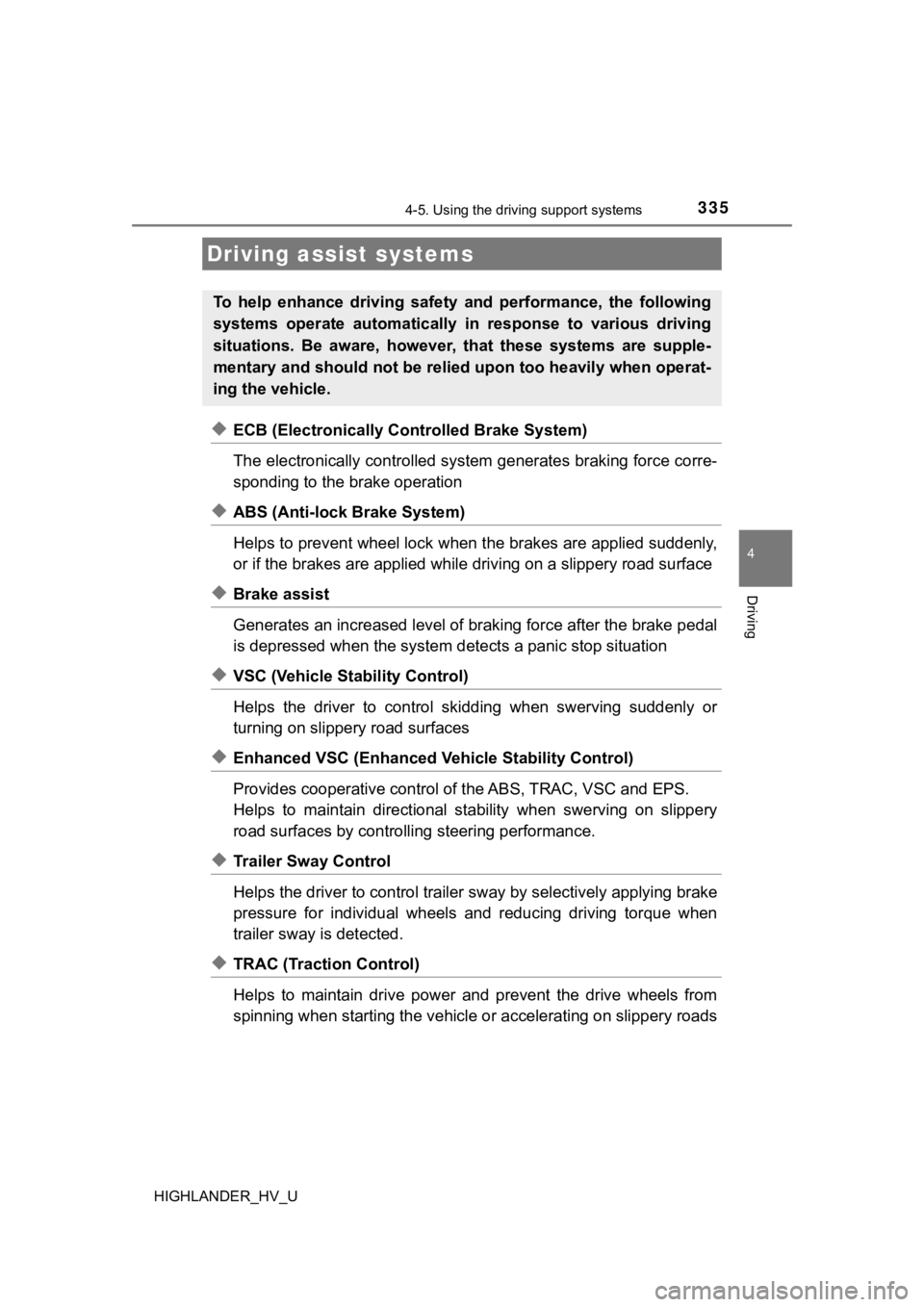
3354-5. Using the driving support systems
4
Driving
HIGHLANDER_HV_U
◆ECB (Electronically Controlled Brake System)
The electronically controlled system generates braking force corre-
sponding to the brake operation
◆ABS (Anti-lock Brake System)
Helps to prevent wheel lock when the brakes are applied suddenl y,
or if the brakes are applied while driving on a slippery road surface
◆Brake assist
Generates an increased level of braking force after the brake p edal
is depressed when the system de tects a panic stop situation
◆VSC (Vehicle Stability Control)
Helps the driver to control skidding when swerving suddenly or
turning on slippery road surfaces
◆Enhanced VSC (Enhanced Vehicle Stability Control)
Provides cooperative control of the ABS, TRAC, VSC and EPS.
Helps to maintain directional stability when swerving on slippe ry
road surfaces by controlling steering performance.
◆Trailer Sway Control
Helps the driver to control tra iler sway by selectively applying brake
pressure for individual wheels and reducing driving torque when
trailer sway is detected.
◆TRAC (Traction Control)
Helps to maintain drive power and prevent the drive wheels from
spinning when starting the vehicl e or accelerating on slippery roads
Driving assist systems
To help enhance driving safety and performance, the following
systems operate autom atically in response to various driving
situations. Be aware, however, that these systems are supple-
mentary and should not be relied upon too heavily when operat-
ing the vehicle.
Page 609 of 716

6098-2. Steps to take in an emergency
8
When trouble arises
HIGHLANDER_HV_U
WARNING
■Replacing a flat tire
●Do not touch the disc wheels or the area around the brakes immedi-
ately after the vehi cle has been driven.
After the vehicle has been driven the disc wheels and the area around
the brakes will be extremely hot. Touching these areas with hands, feet
or other body parts while changin g a tire, etc. may result in burns.
●Failure to follow these precautions could cause the wheel nuts to
loosen and the t ire to fall off, resulting in death or serious injury.
• Have the wheel nuts tightened wit h a torque wrench to 76 ft•lbf (103
N•m, 10.5 kgf•m) as soon as po ssible after changing wheels.
• Do not attach a heavily damaged wheel ornament, as it may fly off
the wheel while the vehicle is moving.
• When installing a tire, only use wheel nuts that have been spe cifi-
cally designed for that wheel.
• If there are any cracks or defo rmations in the bolt screws, nut
threads or bolt holes of the wheel, have the vehicle inspected by
your Toyota dealer.
• When installing the wheel nuts, b e sure to install them with the
tapered ends facing inward. ( P. 536)
●Observe the followi ng precautions.
Failure to do so may result in serious injury:
• Do not try to remove the wheel ornament by hand. Take due care in
handling the ornament to avoid unexpected personal injury.
• Lower the spare tire completely to the ground before removing it
from under the vehicle.
Page 611 of 716
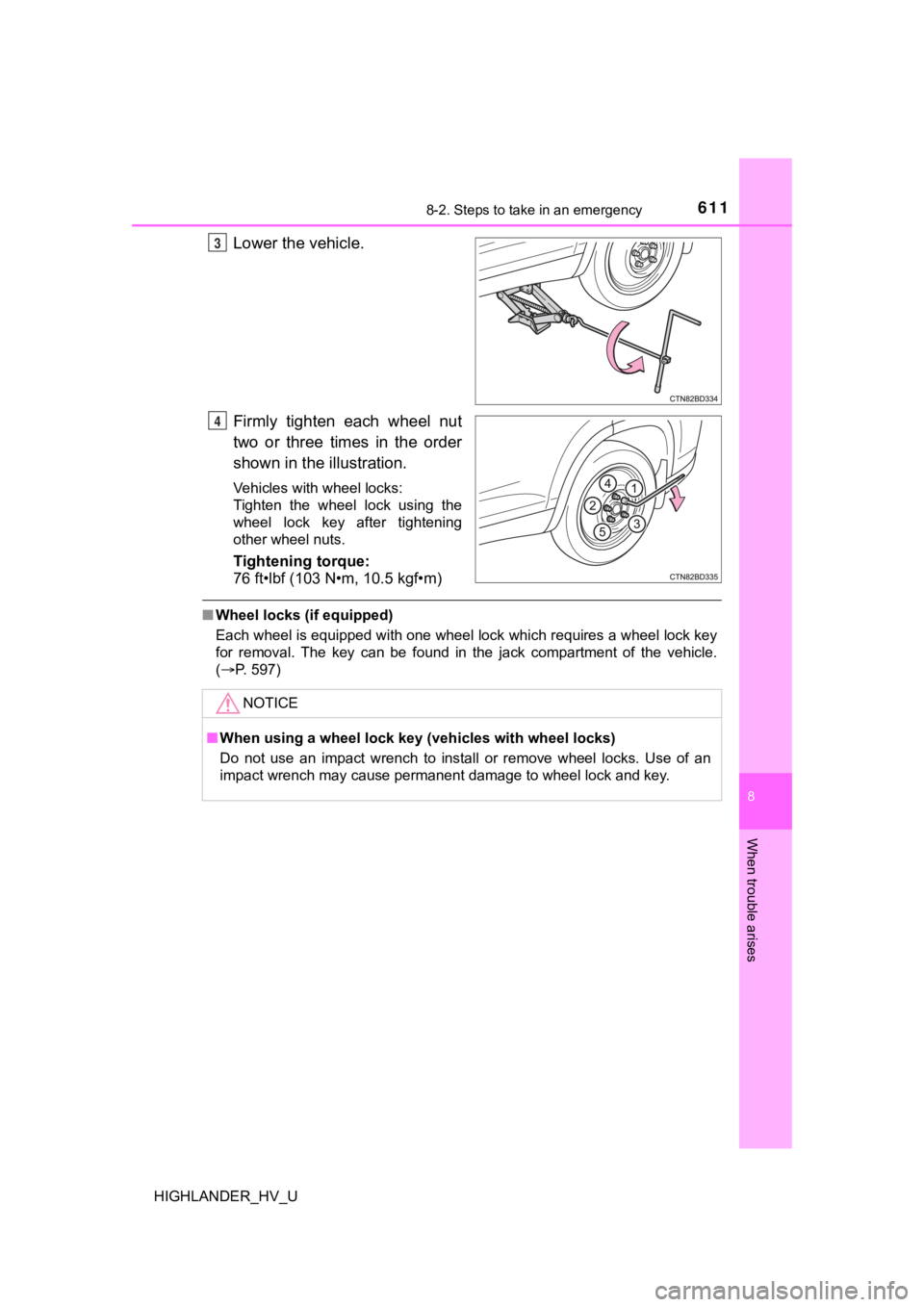
6118-2. Steps to take in an emergency
8
When trouble arises
HIGHLANDER_HV_U
Lower the vehicle.
Firmly tighten each wheel nut
two or three times in the order
shown in the illustration.
Vehicles with wheel locks:
Tighten the wheel lock using the
wheel lock key after tightening
other wheel nuts.
Tightening torque:
76 ft•lbf (103 N•m, 10.5 kgf•m)
■Wheel locks (if equipped)
Each wheel is equipped with one wheel lock which requires a whe el lock key
for removal. The key can be found in the jack compartment of th e vehicle.
( P. 597)
3
4
NOTICE
■ When using a wheel lock key (vehicles with wheel locks)
Do not use an impact wrench to install or remove wheel locks. Use of an
impact wrench may cause permanent damage to wheel lock and key.
Page 646 of 716
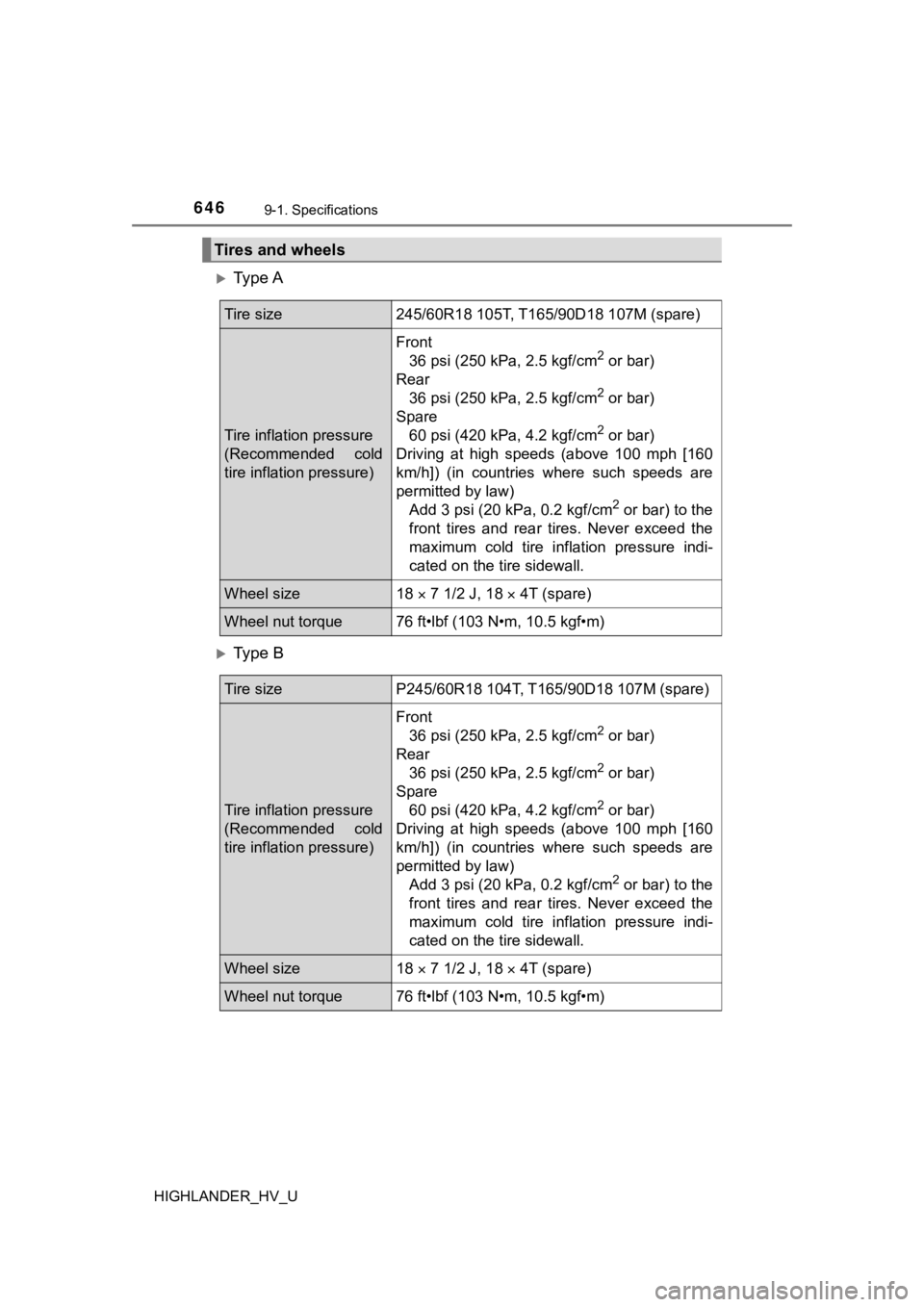
6469-1. Specifications
HIGHLANDER_HV_U
Ty p e A
Ty p e B
Tires and wheels
Tire size245/60R18 105T, T165/90D18 107M (spare)
Tire inflation pressure
(Recommended cold
tire inflation pressure)
Front
36 psi (250 kPa, 2.5 kgf/cm2 or bar)
Rear 36 psi (250 kPa, 2.5 kgf/cm
2 or bar)
Spare 60 psi (420 kPa, 4.2 kgf/cm
2 or bar)
Driving at high speeds (above 100 mph [160
km/h]) (in countries where such speeds are
permitted by law) Add 3 psi (20 kPa, 0.2 kgf/cm
2 or bar) to the
front tires and rear tires. Never exceed the
maximum cold tire inflation pressure indi-
cated on the tire sidewall.
Wheel size18 7 1/2 J, 18 4T (spare)
Wheel nut torque76 ft•lbf (103 N•m, 10.5 kgf•m)
Tire sizeP245/60R18 104T, T165/90D18 107M (spare)
Tire inflation pressure
(Recommended cold
tire inflation pressure)
Front
36 psi (250 kPa, 2.5 kgf/cm2 or bar)
Rear 36 psi (250 kPa, 2.5 kgf/cm
2 or bar)
Spare 60 psi (420 kPa, 4.2 kgf/cm
2 or bar)
Driving at high speeds (above 100 mph [160
km/h]) (in countries where such speeds are
permitted by law) Add 3 psi (20 kPa, 0.2 kgf/cm
2 or bar) to the
front tires and rear tires. Never exceed the
maximum cold tire inflation pressure indi-
cated on the tire sidewall.
Wheel size18 7 1/2 J, 18 4T (spare)
Wheel nut torque76 ft•lbf (103 N•m, 10.5 kgf•m)
Page 647 of 716
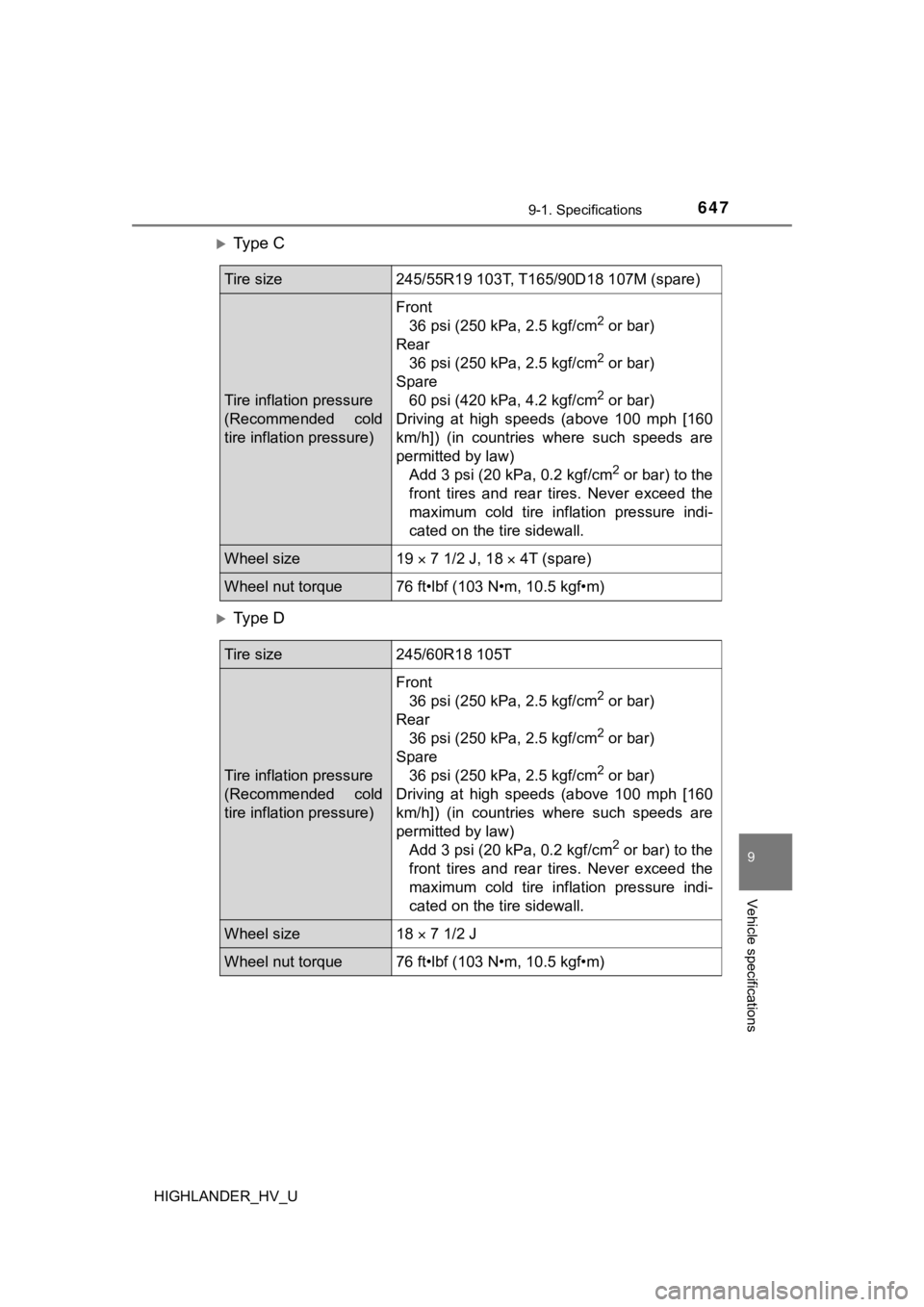
6479-1. Specifications
9
Vehicle specifications
HIGHLANDER_HV_U
Ty p e C
Ty p e D
Tire size245/55R19 103T, T165/90D18 107M (spare)
Tire inflation pressure
(Recommended cold
tire inflation pressure)
Front
36 psi (250 kPa, 2.5 kgf/cm2 or bar)
Rear 36 psi (250 kPa, 2.5 kgf/cm
2 or bar)
Spare 60 psi (420 kPa, 4.2 kgf/cm
2 or bar)
Driving at high speeds (above 100 mph [160
km/h]) (in countries where such speeds are
permitted by law) Add 3 psi (20 kPa, 0.2 kgf/cm
2 or bar) to the
front tires and rear tires. Never exceed the
maximum cold tire inflation pressure indi-
cated on the tire sidewall.
Wheel size19 7 1/2 J, 18 4T (spare)
Wheel nut torque76 ft•lbf (103 N•m, 10.5 kgf•m)
Tire size245/60R18 105T
Tire inflation pressure
(Recommended cold
tire inflation pressure)
Front
36 psi (250 kPa, 2.5 kgf/cm2 or bar)
Rear 36 psi (250 kPa, 2.5 kgf/cm
2 or bar)
Spare 36 psi (250 kPa, 2.5 kgf/cm
2 or bar)
Driving at high speeds (above 100 mph [160
km/h]) (in countries where such speeds are
permitted by law) Add 3 psi (20 kPa, 0.2 kgf/cm
2 or bar) to the
front tires and rear tires. Never exceed the
maximum cold tire inflation pressure indi-
cated on the tire sidewall.
Wheel size18 7 1/2 J
Wheel nut torque76 ft•lbf (103 N•m, 10.5 kgf•m)
Page 648 of 716
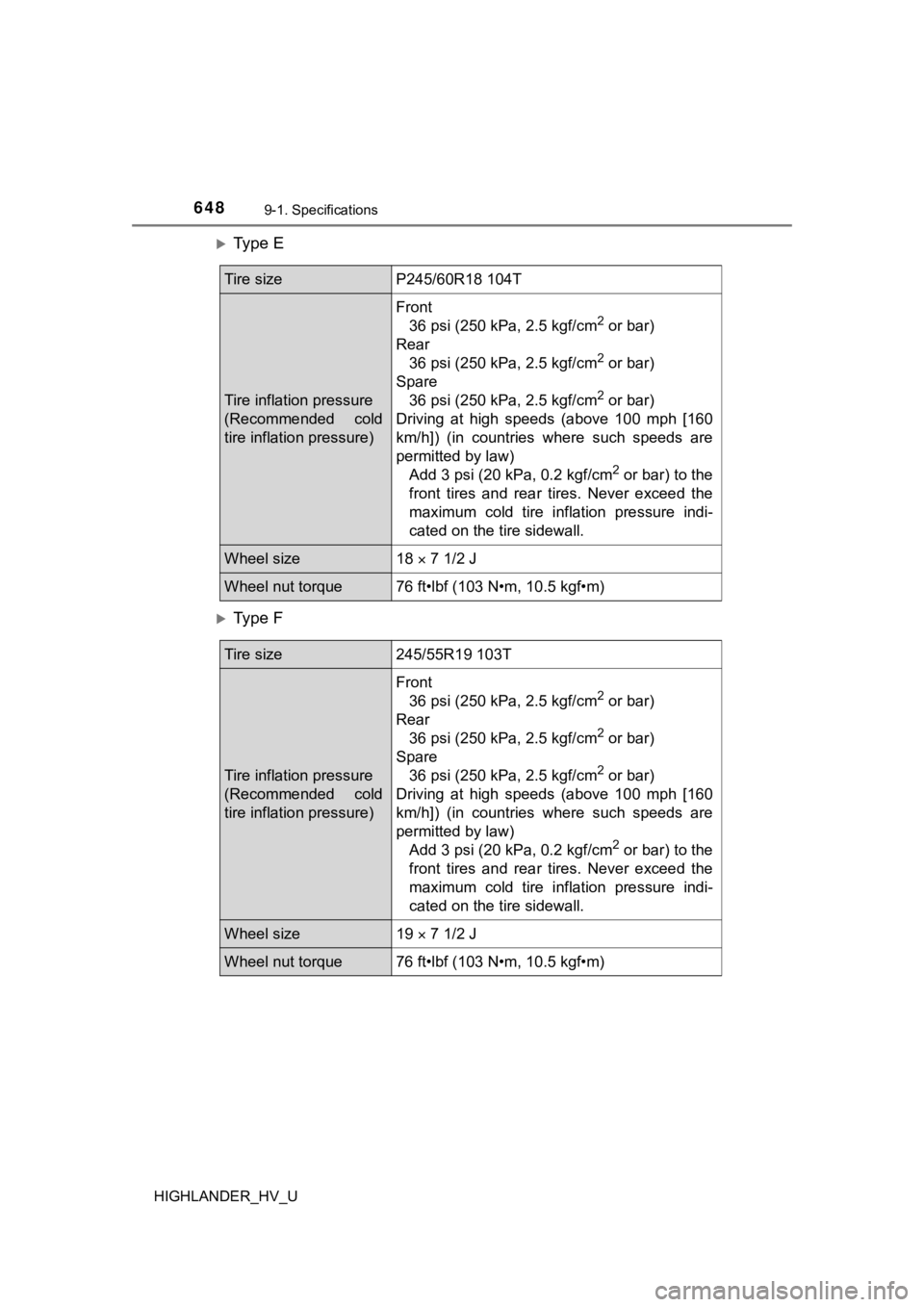
6489-1. Specifications
HIGHLANDER_HV_U
Ty p e E
Ty p e F
Tire sizeP245/60R18 104T
Tire inflation pressure
(Recommended cold
tire inflation pressure)
Front36 psi (250 kPa, 2.5 kgf/cm2 or bar)
Rear 36 psi (250 kPa, 2.5 kgf/cm
2 or bar)
Spare 36 psi (250 kPa, 2.5 kgf/cm
2 or bar)
Driving at high speeds (above 100 mph [160
km/h]) (in countries where such speeds are
permitted by law) Add 3 psi (20 kPa, 0.2 kgf/cm
2 or bar) to the
front tires and rear tires. Never exceed the
maximum cold tire inflation pressure indi-
cated on the tire sidewall.
Wheel size18 7 1/2 J
Wheel nut torque76 ft•lbf (103 N•m, 10.5 kgf•m)
Tire size245/55R19 103T
Tire inflation pressure
(Recommended cold
tire inflation pressure)
Front
36 psi (250 kPa, 2.5 kgf/cm2 or bar)
Rear 36 psi (250 kPa, 2.5 kgf/cm
2 or bar)
Spare 36 psi (250 kPa, 2.5 kgf/cm
2 or bar)
Driving at high speeds (above 100 mph [160
km/h]) (in countries where such speeds are
permitted by law) Add 3 psi (20 kPa, 0.2 kgf/cm
2 or bar) to the
front tires and rear tires. Never exceed the
maximum cold tire inflation pressure indi-
cated on the tire sidewall.
Wheel size19 7 1/2 J
Wheel nut torque76 ft•lbf (103 N•m, 10.5 kgf•m)